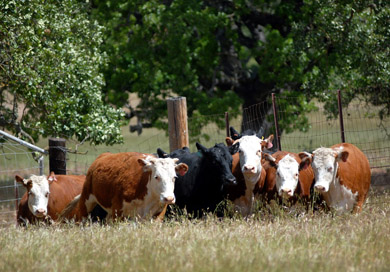
Closer plant will save ranchers time and money
After trying to open a meat packing plant on her San Benito
County Ranch for several years, Sallie Calhoun, owner of Paicines
Ranch, opened a United States Department of Agriculture (USDA)
certified meat packing plant in the Central Valley.
Closer plant will save ranchers time and money
After trying to open a meat packing plant on her San Benito County Ranch for several years, Sallie Calhoun, owner of Paicines Ranch, opened a United States Department of Agriculture (USDA) certified meat packing plant in the Central Valley.
“We ran into the problem of trying to do something unusual,” Calhoun said. “There is nobody opening small plants in California today.”
It was a combination of federal, state and county regulations that killed the project within the county, Calhoun said.
Calhoun’s plant, Cutting Edge Meat, processes cattle, goat, pigs and sheep, Calhoun said. It can cut animals down to steak.
The plant can handle 200 animals per day. A plant in Fresno, not one of the largest, can process 750 animals per day, Calhoun said.
Some local cattle ranchers will use the closer processing plant. Joe Morris, owner of Morris Grassfed Beef in San Juan Bautista, has been a rancher for 20 years.
In the past, Morris logged thousands of miles each year to have his cattle processed at the closest USDA certified facility. The Orland plant is 250 miles each way, Morris said.
“That is a lot of miles and a lot more fuel than we want to be burning,” Morris said.
Located in Newman, Cutting Edge Meat is only 60 miles from Morris’ ranch.
Cattle are processed between mid-April and early July. He will make the trip six times this season.
Decreasing the transportation costs for processing will make his product more price competitive with conventional beef.
“The biggest costs that we have are the cost of the animal, and the processing, which is almost the cost of the animal,” Morris said.
Calhoun did not think that building a meat packing plant in San Benito would be difficult.
“We were silly,” Calhoun said. “We didn’t think that it was going to be a big deal, and the planning department agreed with us for a while. We were all naive.”
The project had tremendous support locally, said Reb Monaco, a member of the San Benito County Board of Supervisors.
“I commend her for trying to do that,” Monaco said. “It is a very costly, high-risk venture for anybody. That’s exactly the reason that you see relatively few of these.
Part of her mission with Cutting Edge is to prove that a small meat packing plant can be a good neighbor, Calhoun said.
Due to concerns about smell, one of her neighbors in San Benito was opposed to a meat packing plant on Paicines Ranch, Calhoun said.
“One neighbor can really have a big impact,” Calhoun said.
The planning process was one problem after another.
Pork was one of the subjects of her first meeting with county planning staff, Calhoun said.
“They had this idea that if you kill a pig it was going to be too dirty,” Calhoun said. “Even though the USDA would have allowed that, we were not going to be able to do that. They were not even going to let us process wild pig.”
Paicines Ranch is zoned for agriculture.
“I thought going in that a meat packing plant was part of ag, but apparently it is not,” Calhoun said.
Land zoned for agricultural allows vegetable packing plants, not meat.
Planning department staff changed the zoning of her property, Calhoun said.
“When they changed the zoning, they put all kinds of limitations on it so that no one could ever put in a bigger plant,” Calhoun said. “There was another gotcha.”
Some meat packing plants are located in industrial areas.
“San Benito County really wanted that to go in an industrial area,” Calhoun said. “Either you have to drive past residential areas and it is one battle after another, or the land becomes too valuable and it does not make any sense to operate a packing plant.”
County staff did try, Calhoun said.
“Doing a project for them is just a big problem,” Calhoun said. “I do not think that they are very ag oriented.”
County staff did not hold up the process, said Richard Bettencourt, a member of San Benito County’s planning commission.
“In my opinion, we fast tracked it,” Bettencourt said. “We gave her everything she wanted.”
San Benito’s planning commission approved the project, Bettencourt said.
A consultant hired by Calhoun advised her that it was best to open a preexisting plant, Bettencourt said.
The problem is not unique to San Benito County, Calhoun said.
“First of all, people don’t want you to build a meat packing plant,” Calhoun said. “They want their meat to come from somewhere, but somewhere else.”
Calhoun wants to be part of the movement to raise, process and sell meat locally.
“The model that we’ve got evolved with very cheap fuel,” Calhoun said. “Over the next 25 years, that is not going to be the case.”
Cattle raised in California might be processed in Wyoming, Calhoun said.
That was not always the case.
There used to be USDA certified facilities in Hollister, Gilroy and Santa Cruz, Morris said.
“And then one way or another they were all closed, and then the [industry] moved to highly centralized processing facilities,” Morris said. “Over the last 50 years, USDA facilities have dwindled from one in every town to one every thousand miles.”
The plant in Newman is the first step to shortening the distance San Benito ranchers need to travel.
“We have to put that infrastructure back in California,” Calhoun said. “It has gotten destroyed over the last 50 years. There are a bunch of us who are trying to do that.”









